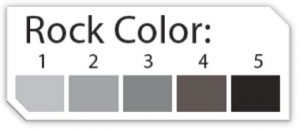For this project rock color was determined on a relative scale of 1 to 5 with 1 being lightest colored and 5 being darkest colored
What does it mean? The color of the rock is very important in helping to determine what type of environment the rock formed in and how much oxygen was present.
Very Dark Colored: If a rock is very dark (closer to 5) chances are it was deposited in an environment that was low in oxygen. This is called an anoxic (without oxygen) environment.
Environments that are low in oxygen cannot support the oxygen-using microorganisms (like bacteria) that most quickly break down organic matter (such as the remains of plants and animals and their waste). Therefore organic material can accumulate in the sediment before it rots away.
Today, common environments with anoxic conditions include swaps and some deeper water and lake environments. In these places the amount of oxygen for microorganisms to use is low compare with the amount of organic matter for them to break down. This happens when the rate of organic matter accumulating is high or where water circulation is poor, or both.
In the Devonian continental sea, deeper areas seem to have circulated less with oxygen-rich water from the surface or flowing from the open ocean, contributing to low oxygen in these areas.
Light Colored: these rocks (closer to 1) are likely to be in environments with lots of oxygen. These tend to be shallower environments where there is plenty of oxygen for microorganisms to break down organic matter in the sediment.

